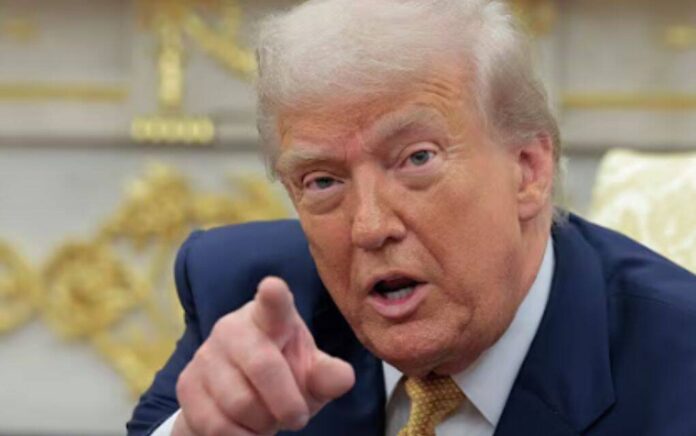
The Trump admin has said they will uphold the rule of law. That includes American citizens.
That’s why the Trump admin’s sent a direct notice to millions of Americans witht his appalling warning.
Trump Administration Overhauls Student Loan System, Ends Biden’s SAVE Plan
The Department of Education, led by Secretary Linda McMahon, has declared that starting August 1, 2025, interest will once again accrue on student loans previously covered under the Saving on a Valuable Education (SAVE) Plan, a program launched by former President Joe Biden. In a video announcement, McMahon stated that the SAVE Plan, which the Supreme Court deemed an unconstitutional overreach in June 2023, will be phased out as part of a larger restructuring of federal student loan policies under President Trump.
Introduced in 2023, the Biden administration promoted the SAVE Plan as a cost-effective repayment solution for borrowers. However, it faced fierce legal challenges, with critics in opinion pieces calling it “straight up buying votes” and accusing it of being a transparent ploy to secure Democratic support. The Supreme Court’s ruling effectively dismantled the plan, paving the way for the Trump administration’s reforms.
President Trump’s administration is moving to eliminate the SAVE Plan and other income-driven repayment programs that promised reduced or eliminated payments for borrowers. These programs, critics argue, unfairly shifted the financial burden onto American taxpayers. The administration’s stance is clear: loan forgiveness is not a solution, as it simply transfers debt from borrowers to the public.
In her announcement, McMahon directed borrowers to StudentAid.gov to explore new repayment options that the Department of Education describes as affordable and legally sound. The department aims to assist borrowers in navigating these alternatives as the SAVE Plan is phased out.
The debate over student loan forgiveness hinges on fairness. Many Republican lawmakers argue that it’s unjust to forgive student loans when countless young Americans join the military to fund their education through service. They also question why the SAVE Plan appeared to prioritize liberal arts majors over those who pursue vocational or trade schools, which often lead to quicker workforce entry.
Signed into law by President Trump on July 4, 2025, the One Big Beautiful Bill Act significantly reforms the federal student loan system, affecting nearly 43 million borrowers. The act imposes stricter borrowing limits and reduces repayment options, with the SAVE Plan set to be fully eliminated by July 1, 2028. Interest accrual will resume on August 1, 2025.
Starting in July 2026, new borrowing caps will limit graduate student loans to $20,500 annually and $100,000 over a lifetime, while professional degrees will be capped at $50,000 per year and $200,000 total. Parent PLUS loans will be restricted to $20,000 annually and $65,000 per child. A combined loan limit of $257,500 will apply to both undergraduate and graduate loans.
Repayment options will be simplified into two plans: a standard plan with terms ranging from 10 to 25 years based on debt size, and the Repayment Assistance Plan (RAP), which ties payments to income. The RAP starts at $10 monthly for those earning $10,000 or less, scaling up to 10% of adjusted gross income for higher earners. It also waives unpaid interest and offers up to $50 monthly principal reduction for low-income borrowers, though a $10 minimum payment is required.
Under the RAP, loan forgiveness is extended to 30 years, compared to 20 or 25 years in previous plans, making it harder for most borrowers to qualify. Borrowers with loans issued before July 1, 2026, can opt for the older Income-Based Repayment (IBR) plan, which offers forgiveness after 20 or 25 years.
Legal challenges surrounding the SAVE Plan have caused administrative delays, leading to a pause in IBR forgiveness processing. The Department of Education has promised refunds for any overpayments made during this period.
Growing Support for Student Loan Repayment Accountability
A growing number of Americans are voicing support for the idea that student loan borrowers should repay their debts like any other financial obligation, according to recent polls and public sentiment. A Rasmussen Reports survey from June 2025 found that 62% of Americans believe student loan forgiveness is unfair, arguing that it rewards one group while burdening taxpayers who never took out such loans. This view aligns with the Trump administration’s push to overhaul the federal student loan system and eliminate programs like the SAVE Plan.
The sentiment is particularly strong among working-class Americans, who often forgo college for trade schools or enter the workforce directly. Many see loan forgiveness as a handout to those who chose expensive degrees, often in fields with limited job prospects. “Why should a welder who paid for his training out of pocket subsidize a sociology major’s debt?” asked John Kessler, a mechanic from Ohio, in a recent interview with a conservative news outlet. This frustration is echoed across heartland communities, where personal responsibility is a core value.
Opponents of loan forgiveness also point to the sacrifices made by those who avoided debt altogether. Military veterans, for example, often cite their service as a means of funding education without loans. “I served four years in the Army to pay for my degree,” said Sarah Thompson, a veteran and small business owner. “It’s not fair to ask taxpayers to cover someone else’s choice to borrow.” This perspective has gained traction, with 58% of respondents in a July 2025 Pew Research poll agreeing that student loan forgiveness undermines personal accountability.
The economic argument against forgiveness is equally compelling. The Committee for a Responsible Federal Budget estimates that broad student loan forgiveness could cost taxpayers up to $1.6 trillion over a decade, a figure that alarms fiscal conservatives. With the national debt already exceeding $35 trillion, many Americans view loan forgiveness as an unsustainable burden. “We can’t keep piling debt on future generations,” said Rep. Tom Cole (R-OK) in a recent House floor speech, emphasizing the need for borrowers to honor their commitments.
Public opinion is also shaped by the perception that loan forgiveness disproportionately benefits higher earners. A 2024 Brookings Institution study found that nearly 70% of student loan debt is held by individuals in the top 40% of income earners, many of whom can afford to repay their loans. This has fueled populist outrage, with Americans questioning why working-class families should subsidize the debts of professionals like doctors and lawyers. The Trump administration’s reforms, including stricter borrowing caps and the phase-out of plans like SAVE, are seen as a step toward leveling the playing field.
The push for accountability resonates strongly in rural and suburban communities, where many feel overlooked by coastal elites. As the 2026 midterm elections approach, Republican candidates are leveraging this sentiment, framing student loan repayment as a matter of fairness and fiscal responsibility. “Americans want a system that rewards hard work, not handouts,” said Sen. J.D. Vance (R-OH) at a recent campaign rally. With public support for loan repayment growing, the Trump administration’s reforms may mark a turning point in the national debate over student debt.



















